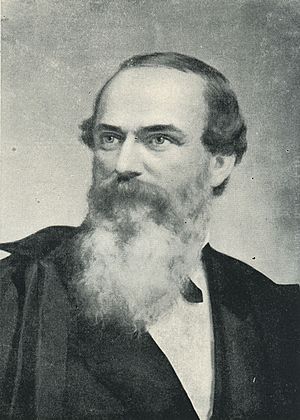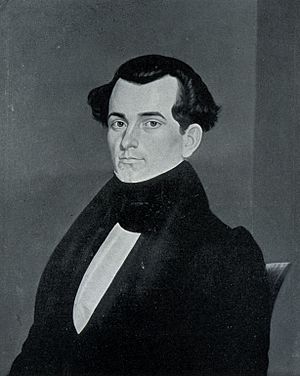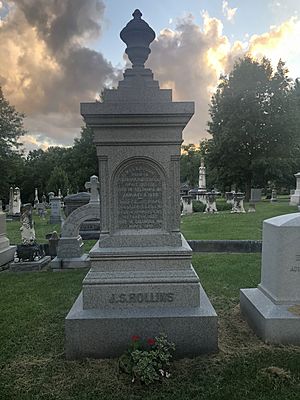James S. Rollins facts for kids
Quick facts for kids
James S. Rollins
|
|
|---|---|
 |
|
| Member of the U.S. House of Representatives from Missouri |
|
| In office March 4, 1861 – March 3, 1865 |
|
| Preceded by | Thomas L. Anderson |
| Succeeded by | George W. Anderson |
| Constituency | 2nd district (1861–63) 9th district (1863–65) |
| Member of the Missouri Legislature | |
| In office 1838 1840 1854 |
|
| Personal details | |
| Born | April 19, 1812 Richmond, Kentucky |
| Died | January 9, 1888 (aged 75) Columbia, Missouri |
| Political party | Whig Constitutional Union Unionist Democratic Republican |
| Spouse | Mary Elizabeth Rollins |
| Signature | |
James Sidney Rollins (born April 19, 1812 – died January 9, 1888) was an important lawyer and politician from Missouri in the 1800s. He is often called the "Father of the University of Missouri" because he worked hard to create the university, helped it get built in Boone County, and found ways to get money for it from the state government.
Rollins also played a big role in Congress when the Thirteenth Amendment was passed, which officially ended slavery in the United States. He changed his vote to support it and spoke powerfully about why it was needed. Rollins was part of several political parties throughout his life, always supporting business growth.
Contents
Early Life and Family

James S. Rollins was born in Richmond, Kentucky, in 1812. His father, Anthony Wayne Rollins, was a doctor. His mother, Sarah Harris Rodes Rollins, was from Virginia.
Rollins went to Richmond Academy and then to Indiana University, graduating in 1830. That same year, his family moved to Boone County, Missouri. Rollins studied law in Columbia, Missouri, for two years.
In 1832, Rollins joined the Black Hawk War and became a Major. After the war, he went to law school at Transylvania University in Kentucky. He became a lawyer in 1834 and started his practice in Columbia.
In 1837, Rollins married Mary Elizabeth Hickman. She was from Franklin, Missouri. They had 11 children together, and seven of them lived to be adults.
Early Political Career
Rollins started his political career as a member of the Whig Party. He was interested in helping businesses and developing resources. In 1836, he bought a Whig newspaper called the Columbia Patriot and edited it for several years. He also worked to get land grants from Congress to build railroads in Missouri.
Serving in the Missouri Legislature
Rollins was elected to the Missouri Legislature in 1838, representing Boone County. He served as a Representative in 1838, 1840, and 1854. He was also a Senator in 1846.
He ran for Governor of Missouri twice, in 1848 and 1857, but he lost both times. The Whig Party broke up around 1855 because of disagreements over slavery. Rollins was a large slave owner, but he did not want slavery to spread to new states. He also opposed states leaving the United States.
After the Whig Party ended, Rollins changed his political party several times. He ran for governor as an independent in 1857. He lost by a small number of votes. When he was not in the legislature, Rollins worked as a lawyer in Columbia.
Founding the University of Missouri
One of the first bills Rollins wrote as a State Representative was to decide where the University of Missouri would be located. His bill said the university should be in one of six central Missouri counties. This bill passed in 1839.
Rollins' law said that the county that raised the most money would get the university. Rollins himself gave a lot of money. He also worked hard to get other people in Boone County to donate. Boone County raised the most money, over $117,000, and won the university.
Rollins continued to support the university. In 1847, he suggested that the state should give money to the school. He also wanted a professor to teach about how to be a good teacher.
U.S. Representative and the Thirteenth Amendment
Rollins was elected to the U.S. Congress in 1860 as a Constitutional Unionist. He was elected again in 1862 as a Unionist.
During the Civil War, Rollins supported the Union. He voted for most laws that helped the war effort. However, he had more traditional views on slavery and African-American rights than many Republicans. He did not support allowing Black people to join the army at first. He also thought the Emancipation Proclamation was only justified as a military action.
In Congress, Rollins helped pass the Pacific Railroad Acts of 1862, which helped build a railroad across the country. He also supported the Morrill Act of 1862, which provided money for state agricultural colleges.
Rollins' support for the Thirteenth Amendment, which ended slavery, was very important. The Senate passed the amendment easily, but the House of Representatives voted against it twice in 1864.
Before the third vote, President Abraham Lincoln personally asked Rollins to support the amendment. Lincoln said it was necessary to keep the country together. Rollins agreed. On January 13, 1865, he gave a long and powerful speech to Congress supporting the amendment. With Rollins' help, the amendment passed by just two votes.
Later Political Career
Rollins did not run for Congress in 1864. He returned to Columbia and supported the Democratic Party candidate for president. In 1866, he was elected as a Democrat to the Missouri House of Representatives. In 1868, he was elected to the State Senate.
Rollins' support for business matched the Republican Party's ideas. However, his views on racial equality kept him from joining the Republicans until after the Reconstruction period. He became a Republican in 1878 and remained one for the rest of his life.
While in the legislature, Rollins focused on helping the University of Missouri. The Civil War had left the university in bad shape and with few students. Rollins worked hard to get state funding for the school.
As a legislator after the war, Rollins helped pass several laws that made the University of Missouri financially stable. These laws also made sure the university stayed in Columbia:
- Money was given for a new President's House and for general funding (1867).
- A Normal Department was created to train school teachers (1867).
- An Agricultural and Mechanical College was established (1870).
- Money from state land sales was invested in higher education (1870 and 1883).
- Bonds were issued to build the new School of Mines in Rolla and to improve the university (1872).
- University tuition was set at a maximum of 10 dollars, making college affordable (1872).

Father of the University of Missouri
When Rollins returned to Columbia in 1872, students and faculty thanked him for his work. The University of Missouri Board of Curators gave Rollins the honorary title of "Pater Universitatis Missouriensis," which means "Father of the University of Missouri."
University of Missouri Board of Curators President
Rollins was first named to the University of Missouri Board of Curators in 1847. He joined the board again in 1869 and became its President that same year. He served as President until 1886, when he had to resign due to poor health.
Friendship with George Caleb Bingham
Rollins was a lifelong friend of the famous artist and politician George Caleb Bingham. Bingham painted many portraits of Rollins and his family. Rollins helped Bingham early in his career by finding people in Columbia who wanted their portraits painted.
Rollins also helped Bingham get a job as the University of Missouri's first art professor. Rollins and Bingham even named their sons after each other. They wrote many letters to each other for over 45 years, discussing personal, social, and political topics.
Death
In 1874, Rollins was hurt in a train accident while traveling. He was in bed for several months. Although he lived for 14 more years, he never fully got his strength back.
James S. Rollins died on January 9, 1888, in Columbia, Missouri. He is buried there at Columbia Cemetery.
Images for kids



